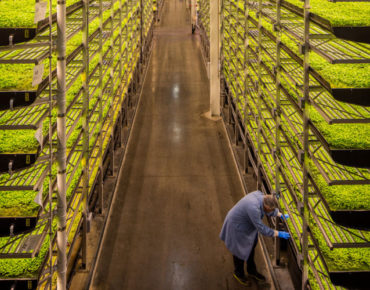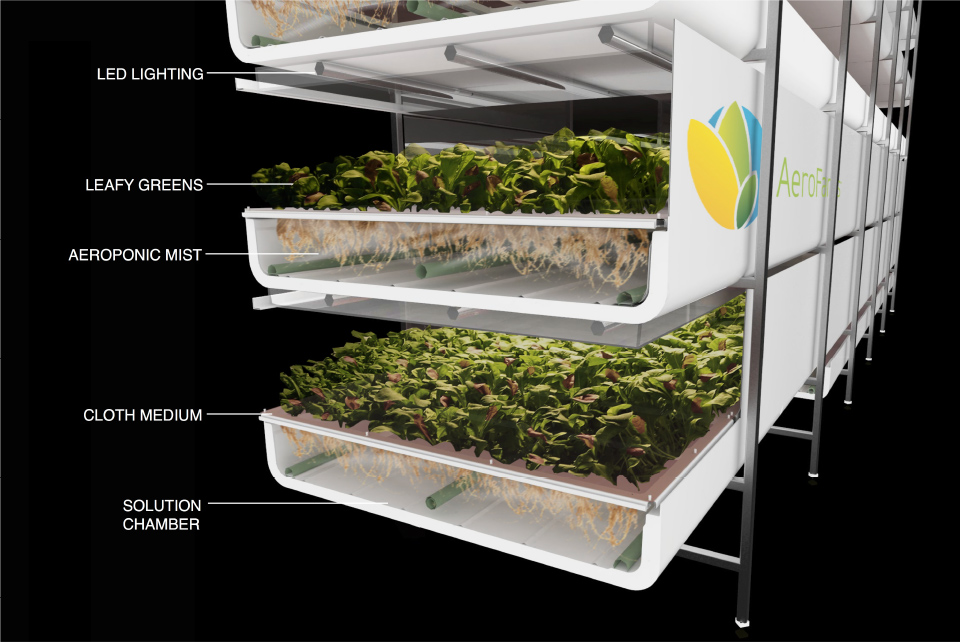Futureworld: The Indoor ‘Vertical Farm’ Driven by IoT and Machine Learning

Source: Aerofarms
Imagine a farm without herbicides, insecticides or pesticides; a farm that cuts water consumption by 95 percent; that uses no fertilizer and thus generates no polluting run-off; that has a dozen crop cycles per year instead of the usual three, making it hundreds of times more productive than conventional farms; a farm that can continually refine the taste and texture of its crops; a farm without sun or soil. That’s right, a farm where the crops don’t need sunlight and don’t grow from the ground.
Such a farm – an “indoor vertical farm” – exists, it’s located in that grittiest, most intensely urban of old industrial cities, Newark, NJ, in a former warehouse. Visitors go from a potholed, chain linked back street into a bright, clean (visitors wear sanitary gowns, gloves, masks and head coverings), 70,000-square-foot facility. Entering it is to experience that rare, uncanny sense of having stepped into the future.
Way into the future.
The farm consists of large, flat platforms stacked 10 levels high (“grow towers”) of leafy green vegetables and herbs thriving in apparent contentment under long rows of LED lights, irrigated with recycled water sprayed on exposed roots dangling from the crops. The process takes place under the watchful “eye” of IoT sensors and machine learning algorithms that analyze the large volumes of continually harvested (sorry!) crop data.
Aerofarms began developing sustainable growing systems since 2004, and has adopted a data-driven strategy that’s a showcase for the IoT and deep learning capabilities of Dell Technologies (see below).
By building farms in major population centers and near major distribution routes (the Newark farm is a mile from the headquarters of one of the largest supermarket chains in the New York City area), the company radically shortens supply chains and lowers energy resources required for “farm to fork” transport while also decreasing spoilage. It enables local farming at commercial scale year-round. And it tracks and monitors its leafy greens from seed to package so that the source of food, if some becomes tainted, can be quickly identified. Taken together, AeroFarms claims to achieve 390 times greater productivity than a conventional field farm while using 5 percent as much water.
“We are as much a capabilities company as we are farmers, utilizing science and technology to achieve our vision of totally controlled agriculture,” said David Rosenberg AeroFarms co-founder and CEO. The company’s vision, he said, is to understand the “symbiotic relationships” among biology, environment and technology, to leverage science and engineering in ways that drive more sustainable, higher-yield food production.
 IoT come into play via AeroFarms’ Connected Food Safety System, which tracks the “growth story” of its products, analyzing more than 130,000 data points per harvest. The growth cycle begins when seeds are germinated on a growing medium that looks like cheesecloth, receiving a measured amount of moisture and nutrients misted directly onto their roots that dangle in a chamber below the growing cloth, along with a spectrum of LED lighting calculated to match the plants’ needs throughout a 12- to 16-day growing cycle.
IoT come into play via AeroFarms’ Connected Food Safety System, which tracks the “growth story” of its products, analyzing more than 130,000 data points per harvest. The growth cycle begins when seeds are germinated on a growing medium that looks like cheesecloth, receiving a measured amount of moisture and nutrients misted directly onto their roots that dangle in a chamber below the growing cloth, along with a spectrum of LED lighting calculated to match the plants’ needs throughout a 12- to 16-day growing cycle.
Rosenberg said Aerofarms decided to partner with Dell because it “offers a comprehensive infrastructure portfolio that spans our IT needs," from edge gateways and rugged tablets to machine learning systems and network gear.
At the edge, sensors and cameras in the aeroponic growing system gather data on everything from moisture and nutrients to light and oxygen and then send operating and growing environment data to Dell IoT Edge Gateways for processing. Information is then relayed over their farm network to Dell Latitude Rugged Tablets and a local server cluster, making it available to Aerofarms workers for monitoring and analysis. AeroFarms’ precision growing algorithms allow just-in-time growing for its selling partners. Once the plants reach maturity, they are harvested and packaged onsite and then distributed to local grocery stores.
Aerofarms is developing a machine learning capability that identifies patterns based on analysis of images and a combination of environmental, machine and historical growing data.
The company said it may expand its use of Microsoft Azure to conduct more analytics in the cloud while leveraging geo-redundant data backup, collect disparate data from its multiple vertical farms and multiple data sources, including information interpreted in historical context, leveraging data previously collected and analyzed over time to improve taste, texture, color, nutrition and yield.
Aerofarms said it also is working on real-time quality control through multi-spectral imaging from its grow trays. Cameras with integrated structured light scanners send data to Dell Edge Gateways, which create 3D topological images of each grow tray. When an anomaly is detected, the gateway sends an alert to operators using Dell Latitude Rugged Tablets on the farm floor.
“For me, the journey started with an appreciation of some of the macro-challenges of the world, starting with water,” said Rosenberg. “Seventy percent of our fresh water goes to agriculture. Seventy percent of our fresh water contamination comes from agriculture.”
Land is another problem.
“By U.N. estimates, we need to produce 50 percent more food by 2050, and we’ve lost 30 percent of our arable farm land in the last 40 years,” he said. “Looking at all those macro-issues, we need a new way to feed our planet.”











